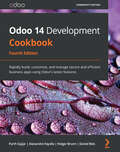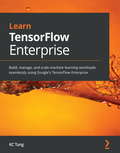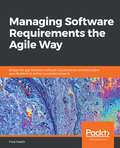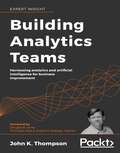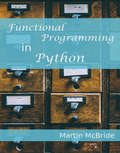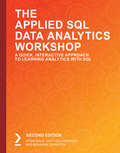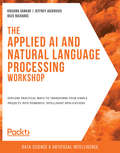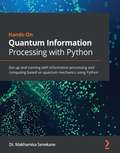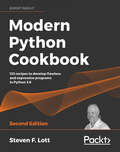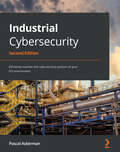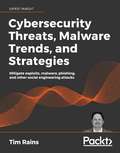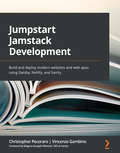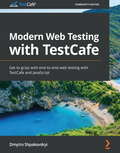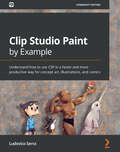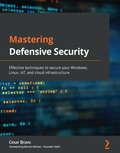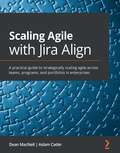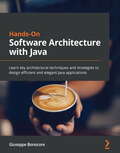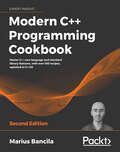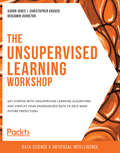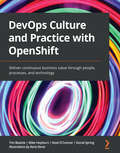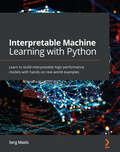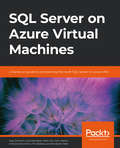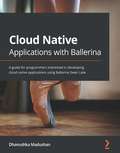- Table View
- List View
Odoo 14 Development Cookbook: Rapidly build, customize, and manage secure and efficient business apps using Odoo's latest features, 4th Edition
by Daniel Reis Holger Brunn Alexandre Fayolle Parth GajjarWith over 200 recipes covering real-world examples, take your Odoo development skills to the next level and solve complex business problems using this guideKey FeaturesLearn to develop new modules and modify existing modules using the Odoo frameworkExplore key concepts of the Odoo framework to build robust business applicationsCreate dynamic websites with snippets and learn to deploy an Odoo instance on the server or Odoo.shBook DescriptionWith its latest iteration, the powerful Odoo framework released a wide variety of features for rapid application development. This updated Odoo development cookbook will help you explore the new features in Odoo 14 and learn how to use them to develop Odoo applications from scratch. You'll learn about the new website concepts in Odoo 14 and get a glimpse of Odoo's new web-client framework, the Odoo Web Library (OWL). Once you've completed the installation, you'll begin to explore the Odoo framework with real-world examples. You'll then create a new Odoo module from the ground up and progress to advanced framework concepts. You'll also learn how to modify existing applications, including Point of Sale (POS) applications. This book isn't just limited to backend development; you'll discover advanced JavaScript recipes for creating new views and widgets. As you progress, you'll learn about website development and become a quality Odoo developer by studying performance optimization, debugging, and automated testing. Finally, you'll delve into advanced concepts such as multi-website, In-App Purchasing (IAP), Odoo.sh, the IoT Box, and security. By the end of the book, you'll have all the knowledge you need to build impressive Odoo applications and you'll be well versed in development best practices that will come in handy when working with the Odoo framework.What you will learnBuild beautiful websites with Odoo CMS using dynamic building blocksGet to grips with advanced concepts such as caching, prefetching, debuggingModify backend JavaScript components and POS applications with the new OWL frameworkConnect and access any object in Odoo via Remote Procedure Calls (RPC)Manage, deploy, and test an Odoo instance with Odoo.shConfigure IoT Box to add and upgrade Point of Sale (POS) hardwareFind out how to implement in-app purchase servicesWho this book is forThis book is suitable for both newcomers and experienced Odoo developers who want to develop a highly efficient business application with the Odoo framework. Basic knowledge of Python and JavaScript is necessary to get the most out of the book.
Learn TensorFlow Enterprise: Build, manage, and scale machine learning workloads seamlessly using Google's TensorFlow Enterprise
by KC TungThis book is for data scientists, machine learning developers or engineers, and cloud practitioners who want to learn and implement various services and features offered by TensorFlow Enterprise from scratch. Basic knowledge of the machine learning development process will be useful.
Managing Software Requirements the Agile Way: Bridge the gap between software requirements and executable specifications to deliver successful projects
by Fred HeathLearn how to deliver software that meets your clients' needs with the help of a structured, end-to-end methodology for managing software requirements and building suitable systems Key Features Learn how to communicate with a project's stakeholders to elicit software requirements Deal every phase of the requirement life cycle with pragmatic methods and techniques Manage the software development process and deliver verified requirements using Scrum and Kanban Book Description Difficulty in accurately capturing and managing requirements is the most common cause of software project failure. Learning how to analyze and model requirements and produce specifications that are connected to working code is the single most fundamental step that you can take toward project success. This book focuses on a delineated and structured methodology that will help you analyze requirements and write comprehensive, verifiable specifications. You'll start by learning about the different entities in the requirements domain and how to discover them based on customer input. You'll then explore tried-and-tested methods such as impact mapping and behavior-driven development (BDD), along with new techniques such as D3 and feature-first development. This book takes you through the process of modeling customer requirements as impact maps and writing them as executable specifications. You'll also understand how to organize and prioritize project tasks using Agile frameworks, such as Kanban and Scrum, and verify specifications against the delivered code. Finally, you'll see how to start implementing the requirements management methodology in a real-life scenario. By the end of this book, you'll be able to model and manage requirements to create executable specifications that will help you deliver successful software projects. What you will learn Kick-start the requirements-gathering and analysis process in your first meeting with the client Accurately define system behavior as features Model and describe requirement entities using Impact Mapping and BDD Create a feature-based product backlog and use it to drive software development Write verification code to turn features into executable specifications Deliver the right software and respond to change using either Scrum or Kanban Choose appropriate software tools to provide transparency and traceability to your clients Who this book is for This book is for software engineers, business analysts, product managers, project managers, and software project stakeholders looking to learn a variety of techniques and methodologies for collating accurate software requirements. A fundamental understanding of the software development life cycle (SDLC) is needed to get started with this book. Although not necessary, basic knowledge of the Agile philosophy and practices, such as Scrum, along with some programming experience will help you to get the most out of this book.
Building Analytics Teams: Harnessing analytics and artificial intelligence for business improvement
by Douglas B. Laney John K. ThompsonMaster the skills necessary to hire and manage a team of highly skilled individuals to design, build, and implement applications and systems based on advanced analytics and AI Key Features Learn to create an operationally effective advanced analytics team in a corporate environment Select and undertake projects that have a high probability of success and deliver the improved top and bottom-line results Understand how to create relationships with executives, senior managers, peers, and subject matter experts that lead to team collaboration, increased funding, and long-term success for you and your team Book Description In Building Analytics Teams, John K. Thompson, with his 30+ years of experience and expertise, illustrates the fundamental concepts of building and managing a high-performance analytics team, including what to do, who to hire, projects to undertake, and what to avoid in the journey of building an analytically sound team. The core processes in creating an effective analytics team and the importance of the business decision-making life cycle are explored to help achieve initial and sustainable success. The book demonstrates the various traits of a successful and high-performing analytics team and then delineates the path to achieve this with insights on the mindset, advanced analytics models, and predictions based on data analytics. It also emphasizes the significance of the macro and micro processes required to evolve in response to rapidly changing business needs. The book dives into the methods and practices of managing, developing, and leading an analytics team. Once you've brought the team up to speed, the book explains how to govern executive expectations and select winning projects. By the end of this book, you will have acquired the knowledge to create an effective business analytics team and develop a production environment that delivers ongoing operational improvements for your organization. What you will learn Avoid organizational and technological pitfalls of moving from a defined project to a production environment Enable team members to focus on higher-value work and tasks Build Advanced Analytics and Artificial Intelligence (AA&AI) functions in an organization Outsource certain projects to competent and capable third parties Support the operational areas that intend to invest in business intelligence, descriptive statistics, and small-scale predictive analytics Analyze the operational area, the processes, the data, and the organizational resistance Who this book is for This book is for senior executives, senior and junior managers, and those who are working as part of a team that is accountable for designing, building, delivering and ensuring business success through advanced analytics and artificial intelligence systems and applications. At least 5 to 10 years of experience in driving your organization to a higher level of efficiency will be helpful.
Mastering QuickBooks 2021: The ultimate guide to bookkeeping and QuickBooks Online, 2nd Edition
by Crystalynn SheltonThis second edition of the bestselling Mastering QuickBooks 2020 is updated and improved to focus on advanced QBO features, techniques for managing sales taxes, and budgeting and reporting best practicesKey FeaturesUnderstand how to manage sales taxes and transactionsExplore advanced bookkeeping techniques such as using the custom chart builder, importing budgets, and performing smart reporting with FathomBecome proficient in using QuickBooks Online and implement best practices to avoid costly errorsBook DescriptionIntuit QuickBooks is an accounting software package that helps small business owners to manage all their bookkeeping tasks independently. This latest edition of Mastering QuickBooks takes you through the range of new features and updates available in QuickBooks Online (QBO). Creating multilingual invoices, tracking mileage, working with a cash flow dashboard that helps you with cash forecasting and planning reports, and uploading a batch of bills and checks are just a few of the new features covered in this edition. As you progress, you'll learn how to manage sales tax, including how to set up, collect, track, pay, and report sales tax payments. Dedicated sections will also take you through new content focused on the latest features in the QBO line-up, while also showing you the different types of businesses that can benefit from QBO Advanced. In addition to this, you'll explore how to export reports to Google Sheets, use the custom chart builder, import budgets, perform smart reporting with Fathom, and much more. By the end of this QuickBooks book, you'll be well-versed with the features of QuickBooks and have the confidence to manage all your bookkeeping tasks with ease.What you will learnDiscover the new features of QBO and find out what the QBO line-up offersGet to grips with bookkeeping concepts and the typical bookkeeping and financial accounting cycleSet up QuickBooks for both product-based and service-based businessesTrack everything from billable and non-billable time and expenses to profitGenerate key financial reports for accounts, customers, jobs, and invoice itemsUnderstand the complete QuickBooks payroll process and track payments made to 1099 contractorsManage various bank and credit accounts linked to your businessWho this book is forThe book is for small business owners and bookkeepers or accounting students who want to learn QuickBooks Online and understand how to implement and use it effectively. Whether you're a bookkeeping beginner or have some experience already, this book will help you learn to use Intuit QuickBooks Online confidently.
Functional Programming in Python: Explore what functional programming is, how it is used, and the features of Python that support it
by Martin McBrideLearn functional programming concepts and techniques to build Python applications Key Features Study in detail all aspects of functional programming, including immutability, generators, and more Reinforce your learning through elaborate examples Learn how to implement advanced topics like closures, memoization, and monads in your applications Book Description Python supports four programming paradigms – imperative, procedural, object-oriented, and functional. Of these, functional programming is probably the least understood and the least used. This book covers several topics that are directly and indirectly related to functional programming. After a quick overview of functional programming and its characteristics, Functional Programming in Python explains the various concepts of Python, starting with functions. You'll learn how to change the value of an object by using mutability. You'll then look at recursion as a more functional alternative to looping for certain algorithms, and learn how memoization alleviates the limitations of recursion in certain situations. The book further explains how to use closures as function factories and how to handle errors and exceptions with functors and monads. By the end of this book, you'll have all the knowledge you need for developing your applications with functional programming in Python. What you will learn Understand the advantages and disadvantages of functional programming Use closures in your code to dynamically create functions Create your own iterators Use the general-purpose functools to create your own specialized reducing functions Study and implement list and generator comprehensions to create lists Create customized iterators with generators Who this book is for If you are a developer looking to create applications in Python using functional programming, this book is ideal for you. You will only need a basic knowledge of Python. Prior knowledge or experience of functional programming is not required.
The Applied SQL Data Analytics Workshop: A Quick, Interactive Approach to Learning Analytics with SQL, 2nd Edition
by Benjamin Johnston Upom Malik Matt GoldwasserCut through the noise and get real results with a step-by-step approach to learning about SQL data analysis Key Features Ideal for SQL beginners who are getting started with data analytics for the first time A step-by-step SQL tutorial with exercises and activities that help build key skills Structured to let you progress at your own pace, on your own terms Use your physical print copy to redeem free access to the online interactive edition Book Description You already know that you want to learn data analysis with SQL, and a smarter way to learn is to learn by doing. The Applied SQL Data Analytics Workshop focuses on building up your practical skills so that you can navigate and compose custom reports like an expert data analyst. You'll learn from real examples that lead to real results. Throughout The Applied SQL Data Analytics Workshop, you'll take an engaging step-by-step approach to understand data analytics with SQL. You won't have to sit through any unnecessary theory. You can jump into a single exercise each day if you're short on time, or you can spend an entire weekend tinkering with SQLAlchemy and Python. It's your choice. Learning on your terms, you'll build up and reinforce key skills in a way that feels rewarding. Every physical print copy of The Applied SQL Data Analytics Workshop unlocks access to the interactive edition. With videos detailing all exercises and activities, you'll always have a guided solution. You can also benchmark yourself against assessments, track progress, and receive content updates. You'll even earn a secure credential that you can share and verify online upon completion. It's a premium learning experience that's included with your printed copy. To redeem, follow the instructions located at the start of your book. Fast-paced and direct, The Applied SQL Data Analytics Workshop is the ideal companion for SQL beginners. You'll perform SQL queries like a professional data scientist, learning along the way. This process means that you'll find that your new skills stick, embedded as best practice. A solid foundation for the years ahead. What you will learn Experiment with data analytics using basic and advanced queries Learn data interpretation through descriptive statistics and aggregate functions Export data from outside sources using powerful SQL queries Discover how to work with and manipulate data using SQL joins and constraints Speed up your data analysis workflow by automating tasks and optimizing queries Discover different advanced analytics techniques, including geospatial and text analysis Who this book is for Our goal at Packt is to help you be successful, in whatever it is you choose to do. The Applied SQL Data Analytics Workshop is an ideal tutorial for the beginner who wants to perform data analysis with SQL and is just getting started. Pick up a Workshop today, and let Packt help you develop skills that stick with you for life.
The Applied AI and Natural Language Processing Workshop - Second Edition: Explore practical ways to transform your simple projects into powerful intelligent applications
by Krishna Sankar Jeffrey JackovichIf you are a machine learning enthusiast, data scientist, or programmer who wants to explore AWS's artificial intelligence and machine learning capabilities, this book is for you. Although not necessary, a basic understanding of AI and NLP will assist with grasping key topics quickly.
Hands-On Quantum Information Processing with Python: Get up and running with information processing and computing based on quantum mechanics using Python
by Dr. Makhamisa SenekaneExplore the potential of quantum information processing and understand the state of a quantum system with this practical guideKey FeaturesGet well-versed with quantum information processing using PythonUnderstand the basics of quantum cryptography by implementing quantum key distribution protocols in PythonImplement well-known games such as the CHSH and GHZ games using quantum strategies and techniquesBook DescriptionQuantum computation is the study of a subclass of computers that exploits the laws of quantum mechanics to perform certain operations that are thought to be difficult to perform on a non-quantum computer. Hands-On Quantum Information Processing with Python begins by taking you through the essentials of quantum information processing to help you explore its potential. Next, you'll become well-versed with the fundamental property of quantum entanglement and find out how to illustrate this using the teleportation protocol. As you advance, you'll discover how quantum circuits and algorithms such as Simon's algorithm, Grover's algorithm, and Shor's algorithm work, and get to grips with quantum cryptography by implementing important quantum key distribution (QKD) protocols in Python. You will also learn how to implement non-local games such as the CHSH game and the GHZ game by using Python. Finally, you'll cover key quantum machine learning algorithms, and these implementations will give you full rein to really play with and fully understand more complicated ideas. By the end of this quantum computing book, you will have gained a deeper understanding and appreciation of quantum information.What you will learnDiscover how quantum circuits and quantum algorithms workFamiliarize yourself with non-local games and learn how to implement themGet to grips with various quantum computing modelsImplement quantum cryptographic protocols such as BB84 and B92 in PythonExplore entanglement and teleportation in quantum systemsFind out how to measure and apply operations to qubitsDelve into quantum computing with the continuous-variable quantum stateGet acquainted with essential quantum machine learning algorithmsWho this book is forThis book is for developers, programmers, or undergraduates in computer science who want to learn about the fundamentals of quantum information processing. A basic understanding of the Python programming language is required, and a good grasp of math and statistics will be useful to get the best out of this book.
Modern Python Cookbook: 133 recipes to develop flawless and expressive programs in Python 3.8, 2nd Edition
by Steven F. LottComplete recipes spread across 15 chapters to help you overcome commonly faced issues by Python for everybody across the globe. Each recipe takes a problem-solution approach to resolve for effective Python. Key Features Develop expressive and effective Python programs Best practices and common idioms through carefully explained recipes Discover new ways to apply Python for data-focused development Make use of Python's optional type annotations Book Description Python is the preferred choice of developers, engineers, data scientists, and hobbyists everywhere. It is a great language that can power your applications and provide great speed, safety, and scalability. It can be used for simple scripting or sophisticated web applications. By exposing Python as a series of simple recipes, this book gives you insight into specific language features in a particular context. Having a tangible context helps make the language or a given standard library feature easier to understand. This book comes with 133 recipes on the latest version of Python 3.8. The recipes will benefit everyone, from beginners just starting out with Python to experts. You'll not only learn Python programming concepts but also how to build complex applications. The recipes will touch upon all necessary Python concepts related to data structures, object oriented programming, functional programming, and statistical programming. You will get acquainted with the nuances of Python syntax and how to effectively take advantage of it. By the end of this Python book, you will be equipped with knowledge of testing, web services, configuration, and application integration tips and tricks. You will be armed with the knowledge of how to create applications with flexible logging, powerful configuration, command-line options, automated unit tests, and good documentation. What you will learn See the intricate details of the Python syntax and how to use it to your advantage Improve your coding with Python readability through functions Manipulate data effectively using built-in data structures Get acquainted with advanced programming techniques in Python Equip yourself with functional and statistical programming features Write proper tests to be sure a program works as advertised Integrate application software using Python Who this book is for The Python book is for web developers, programmers, enterprise programmers, engineers, and big data scientists. If you are a beginner, this book will get you started. If you are experienced, it will expand your knowledge base. A basic knowledge of programming would help.
Industrial Cybersecurity: Efficiently monitor the cybersecurity posture of your ICS environment, 2nd Edition
by Pascal AckermanGet up and running with industrial cybersecurity monitoring with this hands-on book, and explore ICS cybersecurity monitoring tasks, activities, tools, and best practicesKey FeaturesArchitect, design, and build ICS networks with security in mindPerform a variety of security assessments, checks, and verificationsEnsure that your security processes are effective, complete, and relevantBook DescriptionWith Industrial Control Systems (ICS) expanding into traditional IT space and even into the cloud, the attack surface of ICS environments has increased significantly, making it crucial to recognize your ICS vulnerabilities and implement advanced techniques for monitoring and defending against rapidly evolving cyber threats to critical infrastructure. This second edition covers the updated Industrial Demilitarized Zone (IDMZ) architecture and shows you how to implement, verify, and monitor a holistic security program for your ICS environment. You'll begin by learning how to design security-oriented architecture that allows you to implement the tools, techniques, and activities covered in this book effectively and easily. You'll get to grips with the monitoring, tracking, and trending (visualizing) and procedures of ICS cybersecurity risks as well as understand the overall security program and posture/hygiene of the ICS environment. The book then introduces you to threat hunting principles, tools, and techniques to help you identify malicious activity successfully. Finally, you'll work with incident response and incident recovery tools and techniques in an ICS environment. By the end of this book, you'll have gained a solid understanding of industrial cybersecurity monitoring, assessments, incident response activities, as well as threat hunting.What you will learnMonitor the ICS security posture actively as well as passivelyRespond to incidents in a controlled and standard wayUnderstand what incident response activities are required in your ICS environmentPerform threat-hunting exercises using the Elasticsearch, Logstash, and Kibana (ELK) stackAssess the overall effectiveness of your ICS cybersecurity programDiscover tools, techniques, methodologies, and activities to perform risk assessments for your ICS environmentWho this book is forIf you are an ICS security professional or anyone curious about ICS cybersecurity for extending, improving, monitoring, and validating your ICS cybersecurity posture, then this book is for you. IT/OT professionals interested in entering the ICS cybersecurity monitoring domain or searching for additional learning material for different industry-leading cybersecurity certifications will also find this book useful.
Cybersecurity Threats, Malware Trends, and Strategies: Mitigate exploits, malware, phishing, and other social engineering attacks
by Tim RainsAfter scrutinizing numerous cybersecurity strategies, Microsoft's former Global Chief Security Advisor provides unique insights on the evolution of the threat landscape and how enterprises can address modern cybersecurity challenges. Key Features Protect your organization from cybersecurity threats with field-tested strategies by the former most senior security advisor at Microsoft Discover the most common ways enterprises initially get compromised Measure the effectiveness of your organization's current cybersecurity program against cyber attacks Book Description Cybersecurity Threats, Malware Trends, and Strategies shares numerous insights about the threats that both public and private sector organizations face and the cybersecurity strategies that can mitigate them. The book provides an unprecedented long-term view of the global threat landscape by examining the twenty-year trend in vulnerability disclosures and exploitation, nearly a decade of regional differences in malware infections, the socio-economic factors that underpin them, and how global malware has evolved. This will give you further perspectives into malware protection for your organization. It also examines internet-based threats that CISOs should be aware of. The book will provide you with an evaluation of the various cybersecurity strategies that have ultimately failed over the past twenty years, along with one or two that have actually worked. It will help executives and security and compliance professionals understand how cloud computing is a game changer for them. By the end of this book, you will know how to measure the effectiveness of your organization's cybersecurity strategy and the efficacy of the vendors you employ to help you protect your organization and yourself. What you will learn Discover cybersecurity strategies and the ingredients critical to their success Improve vulnerability management by reducing risks and costs for your organization Learn how malware and other threats have evolved over the past decade Mitigate internet-based threats, phishing attacks, and malware distribution sites Weigh the pros and cons of popular cybersecurity strategies of the past two decades Implement and then measure the outcome of a cybersecurity strategy Learn how the cloud provides better security capabilities than on-premises IT environments Who this book is for This book is for senior management at commercial sector and public sector organizations, including Chief Information Security Officers (CISOs) and other senior managers of cybersecurity groups, Chief Information Officers (CIOs), Chief Technology Officers (CTOs) and senior IT managers who want to explore the entire spectrum of cybersecurity, from threat hunting and security risk management to malware analysis. Governance, risk, and compliance professionals will also benefit. Cybersecurity experts that pride themselves on their knowledge of the threat landscape will come to use this book as a reference.
Jumpstart Jamstack Development: Build and deploy modern websites and web apps using Gatsby, Netlify, and Sanity
by Christopher Pecoraro Vincenzo Gambino Magnus Kongsli HillestadLeverage Jamstack principles, techniques, and best practices to build dynamic websites and web apps focused on speed, security, and accessibilityKey FeaturesUnderstand how JavaScript integrates with reusable application program interfaces (APIs) and browser markup to build a serverless web applicationGain a solid understanding of static site development with Gatsby and its importance in JamstackFind out how to deploy a Jamstack event website directly from GitHub using NetlifyBook DescriptionJamstack (JavaScript, API, and Markup) enables web developers to create and publish modern and maintainable websites and web apps focused on speed, security, and accessibility by using tools such as Gatsby, Sanity, and Netlify. Developers working with Jamstack will be able to put their knowledge to good use with this practical guide to static site generation and content management. This Jamstack book takes a hands-on approach to implementation and related methodologies that will have you up and running with modern web development in no time.Complete with step-by-step explanations of essential concepts, practical examples, and self-assessment questions, you'll begin by building an event and venue schema structure, and then expand the functionality, exploring all that the Jamstack has to offer. You'll learn how an example Jamstack is built, build structured content using Sanity to create a schema, use GraphQL to expose the content, and employ Gatsby to build an event website using page and template components and Tailwind CSS Framework. Lastly, you'll deploy the website to both, a Netlify server and the Microsoft Static Web Apps Service, and interact with it using Amazon Alexa.By the end of this book, you'll have gained the knowledge and skills you need to install, configure, build, extend, and deploy a simple events website using Jamstack.What you will learnDiscover the Jamstack approach and build speedy, secure, and accessible websites and web apps with its component technologiesBuild an events website by using the Jamstack and the Gatsby static site generatorCreate and modify your templates and pages to build creative web appsBuild, modify, and extend structured content schemas in SanityUnderstand Gatsby plugins, project structure, and files, and how it can be used to build Jamstack appsFind out how GatsbyJS uses GraphQL to source contentWho this book is forThis book is for web developers looking to implement Jamstack practically. JavaScript developers who want to build modern speedy and secure web apps will also find this book useful. Familiarity with JavaScript and Database programming is assumed.
Modern Web Testing with TestCafe: Get to grips with end-to-end web testing with TestCafe and JavaScript
by Dmytro ShpakovskyiThe book is for QA professionals, test engineers, software engineers, and test automation enthusiasts looking for hands-on guidance on learning about TestCafe. This book is also great for full-stack developers who want to learn more about new tools for testing their code. The book assumes a basic understanding of JavaScript, Node.js, HTML, and CSS.
Clip Studio Paint by Example: Understand how to use CSP in a faster and more productive way for concept art, illustrations, and comics
by Ludovico SerraGet up to speed with the essential tools and workflows for creating a professional portfolio using Clip Studio PaintKey FeaturesExplore the different art tools available for creating your own illustrations, comics, and animationsLearn how to make best use of Clip Studio Paint by implementing it in real-world scenariosUse Clip Studio Paint to leverage your artistic skills and create a portfolioBook DescriptionClip Studio Paint is powerful art software that can help you create artistic work with its in-built material organizer, 3D integration, and group work features. It also provides other features that can speed up the workflow of illustrators, concept artists, and comic artists. With Clip Studio Paint by Example, you'll learn how to use CSP effectively for a wide variety of artistic purposes. The book starts by helping you create the right workspace for concept art, illustration, and comics. You'll create a brush, set up a canvas, and develop an auto-auction. Along with covering how to work with CS Modeler that comes bundled with CSP, this book shows you how to import and rig characters easily. You'll then create reusable changeable scenes and a 3D human character in Blender before exploring concept art, illustrations, comics, and how to create your own portfolio. The book features a glossary with brief explanations of all the main CSP functions. The focus of the book is not on drawing or painting but on helping you enhance your artistic skills using Clip Studio Paint to create an impressive portfolio. By the end of this book, you'll be able to use the impressive capabilities of CSP to create beautiful digital art in a productive way.What you will learnExplore Clip Studio Paint and its use casesBecome familiar with the Clip Studio ecosystem for solving your artistic problemsImplement the CS Modeler and import and rig characters easilyCreate reusable and editable scenes and props using CS ModelerBuild a 3D human character using the Blender softwareSet up your workspace using CSP toolsCreate portfolios for your comics, illustrations, and concept artWho this book is forThis Clip Studio Paint book goes beyond the technical stuff that helps beginner-level as well as intermediate artists who are new to working in a digital environment and need a more streamlined and seamless workflow relating to illustrations, concept art, and comics in Clip Studio Paint. No prior knowledge of Clip Studio Paint is required to get started with this book.
Mastering Defensive Security: Effective techniques to secure your Windows, Linux, IoT, and cloud infrastructure
by Cesar Bravo Darren KitchenAn immersive learning experience enhanced with technical, hands-on labs to understand the concepts, methods, tools, platforms, and systems required to master the art of cybersecurityKey FeaturesGet hold of the best defensive security strategies and toolsDevelop a defensive security strategy at an enterprise levelGet hands-on with advanced cybersecurity threat detection, including XSS, SQL injections, brute forcing web applications, and moreBook DescriptionEvery organization has its own data and digital assets that need to be protected against an ever-growing threat landscape that compromises the availability, integrity, and confidentiality of crucial data. Therefore, it is important to train professionals in the latest defensive security skills and tools to secure them. Mastering Defensive Security provides you with in-depth knowledge of the latest cybersecurity threats along with the best tools and techniques needed to keep your infrastructure secure.The book begins by establishing a strong foundation of cybersecurity concepts and advances to explore the latest security technologies such as Wireshark, Damn Vulnerable Web App (DVWA), Burp Suite, OpenVAS, and Nmap, hardware threats such as a weaponized Raspberry Pi, and hardening techniques for Unix, Windows, web applications, and cloud infrastructures. As you make progress through the chapters, you'll get to grips with several advanced techniques such as malware analysis, security automation, computer forensics, and vulnerability assessment, which will help you to leverage pentesting for security.By the end of this book, you'll have become familiar with creating your own defensive security tools using IoT devices and developed advanced defensive security skills.What you will learnBecome well versed with concepts related to defensive securityDiscover strategies and tools to secure the most vulnerable factor – the userGet hands-on experience using and configuring the best security toolsUnderstand how to apply hardening techniques in Windows and Unix environmentsLeverage malware analysis and forensics to enhance your security strategySecure Internet of Things (IoT) implementationsEnhance the security of web applications and cloud deploymentsWho this book is forThis book is for IT professionals, including systems administrators, programmers, IT architects, solution engineers, system analysts, data scientists, DBAs, and any IT expert looking to explore the fascinating world of cybersecurity.Cybersecurity professionals who want to broaden their knowledge of security topics to effectively create and design a defensive security strategy for a large organization will find this book useful. A basic understanding of concepts such as networking, IT, servers, virtualization, and cloud is required.
Scaling Agile with Jira Align: A Practical Guide To Strategically Scaling Agile Across Teams, Programs, And Portfolios In Enterprises
by Dean MacNeil Aslam CaderThis book is for portfolio managers, program managers, product managers, product owners, executives, release train engineers, and scrum masters who want to empower their teams to deliver the right things at the right time and quickly respond to changes in the market. Familiarity with Jira Software is necessary; the book will teach you the rest.
Hands-On Software Architecture with Java
by Giuseppe BonocoreThis book is for Java software engineers who want to become software architects and learn everything a modern software architect needs to know. The book is also for software architects, technical leaders, vice presidents of software engineering, and CTOs looking to extend their knowledge and stay up to date with the latest developments in the field of software architecture.
Modern C++ Programming Cookbook: Master C++ core language and standard library features, with over 100 recipes, updated to C++20, 2nd Edition
by Marius BancilaA pragmatic recipe book for acquiring a comprehensive understanding of the complexities and core fundamentals of C++ programming Key Features Explore the latest language and library features of C++20 such as modules, coroutines, concepts, and ranges Shed new light on the core concepts in C++ programming, including functions, algorithms, threading, and concurrency, through practical self-contained recipes Leverage C++ features like smart pointers, move semantics, constexpr, and more for increased robustness and performance Book Description C++ has come a long way to be one of the most widely used general-purpose languages that is fast, efficient, and high-performance at its core. The updated second edition of Modern C++ Programming Cookbook addresses the latest features of C++20, such as modules, concepts, coroutines, and the many additions to the standard library, including ranges and text formatting. The book is organized in the form of practical recipes covering a wide range of problems faced by modern developers. The book also delves into the details of all the core concepts in modern C++ programming, such as functions and classes, iterators and algorithms, streams and the file system, threading and concurrency, smart pointers and move semantics, and many others. It goes into the performance aspects of programming in depth, teaching developers how to write fast and lean code with the help of best practices. Furthermore, the book explores useful patterns and delves into the implementation of many idioms, including pimpl, named parameter, and attorney-client, teaching techniques such as avoiding repetition with the factory pattern. There is also a chapter dedicated to unit testing, where you are introduced to three of the most widely used libraries for C++: Boost.Test, Google Test, and Catch2. By the end of the book, you will be able to effectively leverage the features and techniques of C++11/14/17/20 programming to enhance the performance, scalability, and efficiency of your applications. What you will learn Understand the new C++20 language and library features and the problems they solve Become skilled at using the standard support for threading and concurrency for daily tasks Leverage the standard library and work with containers, algorithms, and iterators Solve text searching and replacement problems using regular expressions Work with different types of strings and learn the various aspects of compilation Take advantage of the file system library to work with files and directories Implement various useful patterns and idioms Explore the widely used testing frameworks for C++ Who this book is for The book is designed for entry- or medium-level C++ programmers who have a basic knowledge of C++ and want to master the language and become prolific modern C++ developers. Experienced C++ programmers can leverage this book to strengthen their command of C++ and find a good reference to many language and library features of C++11/14/17/20.
Modern C++ Programming Cookbook: Master C++ core language and standard library features, with over 100 recipes, updated to C++20
by Marius BancilaA pragmatic recipe book for acquiring a comprehensive understanding of the complexities and core fundamentals of C++ programmingKey FeaturesExplore the latest language and library features of C++20 such as modules, coroutines, concepts, and rangesShed new light on the core concepts in C++ programming, including functions, algorithms, threading, and concurrency, through practical self-contained recipesLeverage C++ features like smart pointers, move semantics, constexpr, and more for increased robustness and performanceBook DescriptionC++ has come a long way to be one of the most widely used general-purpose languages that is fast, efficient, and high-performance at its core. The updated second edition of Modern C++ Programming Cookbook addresses the latest features of C++20, such as modules, concepts, coroutines, and the many additions to the standard library, including ranges and text formatting. The book is organized in the form of practical recipes covering a wide range of problems faced by modern developers. The book also delves into the details of all the core concepts in modern C++ programming, such as functions and classes, iterators and algorithms, streams and the file system, threading and concurrency, smart pointers and move semantics, and many others. It goes into the performance aspects of programming in depth, teaching developers how to write fast and lean code with the help of best practices. Furthermore, the book explores useful patterns and delves into the implementation of many idioms, including pimpl, named parameter, and attorney-client, teaching techniques such as avoiding repetition with the factory pattern. There is also a chapter dedicated to unit testing, where you are introduced to three of the most widely used libraries for C++: Boost.Test, Google Test, and Catch2. By the end of the book, you will be able to effectively leverage the features and techniques of C++11/14/17/20 programming to enhance the performance, scalability, and efficiency of your applications.What you will learnUnderstand the new C++20 language and library features and the problems they solveBecome skilled at using the standard support for threading and concurrency for daily tasksLeverage the standard library and work with containers, algorithms, and iteratorsSolve text searching and replacement problems using regular expressionsWork with different types of strings and learn the various aspects of compilationTake advantage of the file system library to work with files and directoriesImplement various useful patterns and idiomsExplore the widely used testing frameworks for C++Who this book is forThe book is designed for entry- or medium-level C++ programmers who have a basic knowledge of C++ and want to master the language and become prolific modern C++ developers. Experienced C++ programmers can leverage this book to strengthen their command of C++ and find a good reference to many language and library features of C++11/14/17/20.
The Unsupervised Learning Workshop: Get started with unsupervised learning algorithms and simplify your unorganized data to help make future predictions
by Benjamin Johnston Aaron Jones Christopher KrugerLearning how to apply unsupervised algorithms on unlabeled datasets from scratch can be easier than you thought with this beginner's workshop, featuring interesting examples and activities Key Features Get familiar with the ecosystem of unsupervised algorithms Learn interesting methods to simplify large amounts of unorganized data Tackle real-world challenges, such as estimating the population density of a geographical area Book Description Do you find it difficult to understand how popular companies like WhatsApp and Amazon find valuable insights from large amounts of unorganized data? The Unsupervised Learning Workshop will give you the confidence to deal with cluttered and unlabeled datasets, using unsupervised algorithms in an easy and interactive manner. The book starts by introducing the most popular clustering algorithms of unsupervised learning. You'll find out how hierarchical clustering differs from k-means, along with understanding how to apply DBSCAN to highly complex and noisy data. Moving ahead, you'll use autoencoders for efficient data encoding. As you progress, you'll use t-SNE models to extract high-dimensional information into a lower dimension for better visualization, in addition to working with topic modeling for implementing natural language processing (NLP). In later chapters, you'll find key relationships between customers and businesses using Market Basket Analysis, before going on to use Hotspot Analysis for estimating the population density of an area. By the end of this book, you'll be equipped with the skills you need to apply unsupervised algorithms on cluttered datasets to find useful patterns and insights. What you will learn Distinguish between hierarchical clustering and the k-means algorithm Understand the process of finding clusters in data Grasp interesting techniques to reduce the size of data Use autoencoders to decode data Extract text from a large collection of documents using topic modeling Create a bag-of-words model using the CountVectorizer Who this book is for If you are a data scientist who is just getting started and want to learn how to implement machine learning algorithms to build predictive models, then this book is for you. To expedite the learning process, a solid understanding of the Python programming language is recommended, as you'll be editing classes and functions instead of creating them from scratch.
DevOps Culture and Practice with OpenShift: Deliver continuous business value through people, processes, and technology
by Mike Hepburn Noel O'Connor Tim Beattie Donal SpringA practical guide to making the best use of the OpenShift container platform based on the real-life experiences, practices, and culture within Red Hat Open Innovation LabsKey FeaturesLearn how modern software companies deliver business outcomes that matter by focusing on DevOps culture and practicesAdapt Open Innovation Labs culture and foundational practices from the Open Practice LibraryImplement a metrics-driven approach to application, platform, and product, understanding what to measure and how to learn and pivotBook DescriptionDevOps Culture and Practice with OpenShift features many different real-world practices - some people-related, some process-related, some technology-related - to facilitate successful DevOps, and in turn OpenShift, adoption within your organization. It introduces many DevOps concepts and tools to connect culture and practice through a continuous loop of discovery, pivots, and delivery underpinned by a foundation of collaboration and software engineering.Containers and container-centric application lifecycle management are now an industry standard, and OpenShift has a leading position in a flourishing market of enterprise Kubernetes-based product offerings. DevOps Culture and Practice with OpenShift provides a roadmap for building empowered product teams within your organization.This guide brings together lean, agile, design thinking, DevOps, culture, facilitation, and hands-on technical enablement all in one book. Through a combination of real-world stories, a practical case study, facilitation guides, and technical implementation details, DevOps Culture and Practice with OpenShift provides tools and techniques to build a DevOps culture within your organization on Red Hat's OpenShift Container Platform.What you will learnImplement successful DevOps practices and in turn OpenShift within your organizationDeal with segregation of duties in a continuous delivery worldUnderstand automation and its significance through an application-centric viewManage continuous deployment strategies, such as A/B, rolling, canary, and blue-greenLeverage OpenShift's Jenkins capability to execute continuous integration pipelinesManage and separate configuration from static runtime softwareMaster communication and collaboration enabling delivery of superior software products at scale through continuous discovery and continuous deliveryWho this book is forThis book is for anyone with an interest in DevOps practices with OpenShift or other Kubernetes platforms.This DevOps book gives software architects, developers, and infra-ops engineers a practical understanding of OpenShift, how to use it efficiently for the effective deployment of application architectures, and how to collaborate with users and stakeholders to deliver business-impacting outcomes.
Interpretable Machine Learning with Python: Learn to build interpretable high-performance models with hands-on real-world examples
by Serg MasisUnderstand the key aspects and challenges of machine learning interpretability, learn how to overcome them with interpretation methods, and leverage them to build fairer, safer, and more reliable modelsKey FeaturesLearn how to extract easy-to-understand insights from any machine learning modelBecome well-versed with interpretability techniques to build fairer, safer, and more reliable modelsMitigate risks in AI systems before they have broader implications by learning how to debug black-box modelsBook DescriptionDo you want to understand your models and mitigate risks associated with poor predictions using machine learning (ML) interpretation? Interpretable Machine Learning with Python can help you work effectively with ML models. The first section of the book is a beginner's guide to interpretability, covering its relevance in business and exploring its key aspects and challenges. You'll focus on how white-box models work, compare them to black-box and glass-box models, and examine their trade-off. The second section will get you up to speed with a vast array of interpretation methods, also known as Explainable AI (XAI) methods, and how to apply them to different use cases, be it for classification or regression, for tabular, time-series, image or text. In addition to the step-by-step code, the book also helps the reader to interpret model outcomes using examples. In the third section, you'll get hands-on with tuning models and training data for interpretability by reducing complexity, mitigating bias, placing guardrails, and enhancing reliability. The methods you'll explore here range from state-of-the-art feature selection and dataset debiasing methods to monotonic constraints and adversarial retraining. By the end of this book, you'll be able to understand ML models better and enhance them through interpretability tuning.What you will learnRecognize the importance of interpretability in businessStudy models that are intrinsically interpretable such as linear models, decision trees, and Naive BayesBecome well-versed in interpreting models with model-agnostic methodsVisualize how an image classifier works and what it learnsUnderstand how to mitigate the influence of bias in datasetsDiscover how to make models more reliable with adversarial robustnessUse monotonic constraints to make fairer and safer modelsWho this book is forThis book is for data scientists, machine learning developers, and data stewards who have an increasingly critical responsibility to explain how the AI systems they develop work, their impact on decision making, and how they identify and manage bias. Working knowledge of machine learning and the Python programming language is expected.
SQL Server on Azure Virtual Machines: A hands-on guide to provisioning Microsoft SQL Server on Azure VMs
by Allan Hirt John Martin Louis Davidson Joey D'Antoni Anthony Nocentino Tim Radney Randolph WestLearn how to combine SQL Server's analytics with Azure's flexibility and hybrid connectivity to achieve industry-leading performance and manageability for your cloud database. Key Features Understand platform availability for SQL Server in Azure Explore the benefits and deployment choices offered by SQL IaaS Get to grips with deploying SQL Server on the Linux development ecosystem Book Description Deploying SQL Server on Azure virtual machines allows you to work on full versions of SQL Server in the cloud without having to maintain on-premises hardware. The book begins by introducing you to the SQL portfolio in Azure and takes you through SQL Server IaaS scenarios, before explaining the factors that you need to consider while choosing an OS for SQL Server in Azure VMs. As you progress through the book, you'll explore different VM options and deployment choices for IaaS and understand platform availability, migration tools, and best practices in Azure. In later chapters, you'll learn how to configure storage to achieve optimized performance. Finally, you'll get to grips with the concept of Azure Hybrid Benefit and find out how you can use it to maximize the value of your existing on-premises SQL Server. By the end of this book, you'll be proficient in administering SQL Server on Microsoft Azure and leveraging the tools required for its deployment. What you will learn Choose an operating system for SQL Server in Azure VMs Use the Azure Management Portal to facilitate the deployment process Verify connectivity and network latency in cloud Configure storage for optimal performance and connectivity Explore various disaster recovery options for SQL Server in Azure Optimize SQL Server on Linux Discover how to back up databases to a URL Who this book is for SQL Server on Azure VMs is for you if you are a developer, data enthusiast, or anyone who wants to migrate SQL Server databases to Azure virtual machines. Basic familiarity with SQL Server and managed identities for Azure resources will be a plus.
Cloud Native Applications with Ballerina: A guide for programmers interested in developing cloud native applications using Ballerina Swan Lake
by Dhanushka MadushanLearn how to build scalable cloud native applications with the new-generation Ballerina language using expert tips and best practicesKey FeaturesWork with code samples based on the Ballerina Swan Lake Beta1 versionExplore the in-built networking protocol support in Ballerina to develop secure distributed appsBuild a Ballerina app with an automated CI/CD pipeline with observability to simplify maintenance and deploymentBook DescriptionThe Ballerina programming language was created by WSO2 for the modern needs of developers where cloud native development techniques have become ubiquitous. Ballerina simplifies how programmers develop and deploy cloud native distributed apps and microservices.Cloud Native Applications with Ballerina will guide you through Ballerina essentials, including variables, types, functions, flow control, security, and more. You'll explore networking as an in-built feature in Ballerina, which makes it a first-class language for distributed computing. With this app development book, you'll learn about different networking protocols as well as different architectural patterns that you can use to implement services on the cloud. As you advance, you'll explore multiple design patterns used in microservice architecture and use serverless in Amazon Web Services (AWS) and Microsoft Azure platforms. You will also get to grips with Docker, Kubernetes, and serverless platforms to simplify maintenance and the deployment process. Later, you'll focus on the Ballerina testing framework along with deployment tools and monitoring tools to build fully automated observable cloud applications.By the end of this book, you will have learned how to apply the Ballerina language for building scalable, resilient, secured, and easy-to-maintain cloud native Ballerina projects and applications.What you will learnUnderstand the concepts and models in cloud native architectureGet to grips with the high-level concepts of building applications with the Ballerina languageUse cloud native architectural design patterns to develop cloud native Ballerina applicationsDiscover how to automate, maintain, and observe cloud native Ballerina applicationsUse a container to deploy and maintain a Ballerina application with Docker and KubernetesExplore serverless architecture and use Microsoft Azure and the AWS platform to build serverless applicationsWho this book is forThis Ballerina Swan Lake book is for cloud developers, integration developers, and microservices developers who are facing challenges with legacy tooling and are looking for the latest tools and technologies to solve them. Beginner-level programming knowledge is required before getting started with this Ballerina book.
